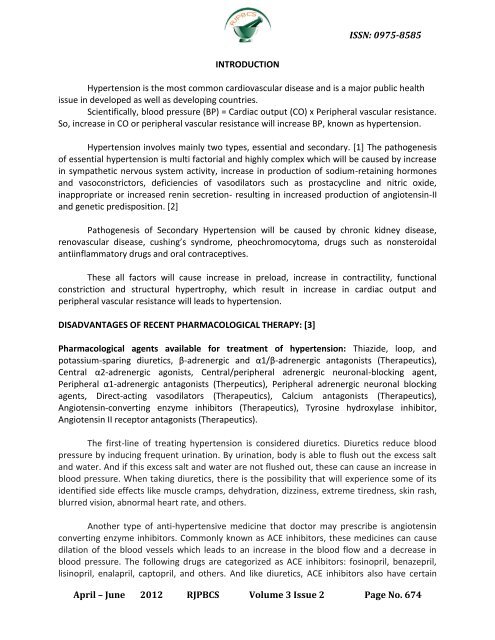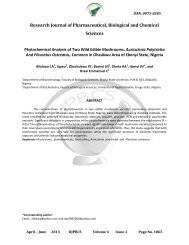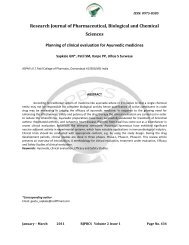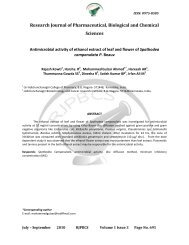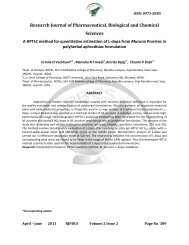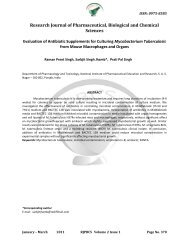Research Journal of Pharmaceutical, Biological and ... - RJPBCS
Research Journal of Pharmaceutical, Biological and ... - RJPBCS
Research Journal of Pharmaceutical, Biological and ... - RJPBCS
You also want an ePaper? Increase the reach of your titles
YUMPU automatically turns print PDFs into web optimized ePapers that Google loves.
INTRODUCTION<br />
ISSN: 0975-8585<br />
Hypertension is the most common cardiovascular disease <strong>and</strong> is a major public health<br />
issue in developed as well as developing countries.<br />
Scientifically, blood pressure (BP) = Cardiac output (CO) x Peripheral vascular resistance.<br />
So, increase in CO or peripheral vascular resistance will increase BP, known as hypertension.<br />
Hypertension involves mainly two types, essential <strong>and</strong> secondary. [1] The pathogenesis<br />
<strong>of</strong> essential hypertension is multi factorial <strong>and</strong> highly complex which will be caused by increase<br />
in sympathetic nervous system activity, increase in production <strong>of</strong> sodium-retaining hormones<br />
<strong>and</strong> vasoconstrictors, deficiencies <strong>of</strong> vasodilators such as prostacycline <strong>and</strong> nitric oxide,<br />
inappropriate or increased renin secretion- resulting in increased production <strong>of</strong> angiotensin-II<br />
<strong>and</strong> genetic predisposition. [2]<br />
Pathogenesis <strong>of</strong> Secondary Hypertension will be caused by chronic kidney disease,<br />
renovascular disease, cushing’s syndrome, pheochromocytoma, drugs such as nonsteroidal<br />
antiinflammatory drugs <strong>and</strong> oral contraceptives.<br />
These all factors will cause increase in preload, increase in contractility, functional<br />
constriction <strong>and</strong> structural hypertrophy, which result in increase in cardiac output <strong>and</strong><br />
peripheral vascular resistance will leads to hypertension.<br />
DISADVANTAGES OF RECENT PHARMACOLOGICAL THERAPY: [3]<br />
Pharmacological agents available for treatment <strong>of</strong> hypertension: Thiazide, loop, <strong>and</strong><br />
potassium-sparing diuretics, β-adrenergic <strong>and</strong> α1/β-adrenergic antagonists (Therapeutics),<br />
Central α2-adrenergic agonists, Central/peripheral adrenergic neuronal-blocking agent,<br />
Peripheral α1-adrenergic antagonists (Therpeutics), Peripheral adrenergic neuronal blocking<br />
agents, Direct-acting vasodilators (Therapeutics), Calcium antagonists (Therapeutics),<br />
Angiotensin-converting enzyme inhibitors (Therapeutics), Tyrosine hydroxylase inhibitor,<br />
Angiotensin II receptor antagonists (Therapeutics).<br />
The first-line <strong>of</strong> treating hypertension is considered diuretics. Diuretics reduce blood<br />
pressure by inducing frequent urination. By urination, body is able to flush out the excess salt<br />
<strong>and</strong> water. And if this excess salt <strong>and</strong> water are not flushed out, these can cause an increase in<br />
blood pressure. When taking diuretics, there is the possibility that will experience some <strong>of</strong> its<br />
identified side effects like muscle cramps, dehydration, dizziness, extreme tiredness, skin rash,<br />
blurred vision, abnormal heart rate, <strong>and</strong> others.<br />
Another type <strong>of</strong> anti-hypertensive medicine that doctor may prescribe is angiotensin<br />
converting enzyme inhibitors. Commonly known as ACE inhibitors, these medicines can cause<br />
dilation <strong>of</strong> the blood vessels which leads to an increase in the blood flow <strong>and</strong> a decrease in<br />
blood pressure. The following drugs are categorized as ACE inhibitors: fosinopril, benazepril,<br />
lisinopril, enalapril, captopril, <strong>and</strong> others. And like diuretics, ACE inhibitors also have certain<br />
April – June 2012 <strong>RJPBCS</strong> Volume 3 Issue 2 Page No. 674


